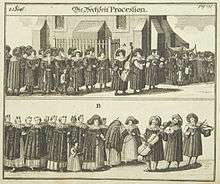Wedding music
Music is often played at wedding celebrations, including during the ceremony and at festivities before or after the event. The music can be performed live by instrumentalists or vocalists or may use pre-recorded songs, depending on the format of the event, traditions associated with the prevailing culture and the wishes of the couple being married.

Entry and ceremony
There are many different styles of music that can be played during the entrance and ceremony.[1] During the service there may be a few hymns, especially in liturgical settings. While some elements of the ceremony may be personalized for a specific couple, the order of service will most of the time follow a similar pattern.[2]
A prelude often precedes the wedding. During the prelude, guests arrive to the gathering place while ambiance music is being played. Calm and light music is usually performed at that time, setting the mood for the ceremony while not being too distracting for the guests. Popular prelude music includes Air on the G string and Jesu, Joy of Man's Desiring by Johann Sebastian Bach.
Music can be used to announce the arrival of the participants of the wedding (such as a bride's processional), and in many western cultures, this takes the form of a wedding march. For more than a century, the Bridal Chorus from Wagner's Lohengrin (1850), often called "Here Comes The Bride", has been the most popular processional, and is traditionally played on a pipe organ.[3]
Some couples may consider traditional wedding marches clichéd and choose a more modern piece of music or an alternative such as Canon in D by Johann Pachelbel. Since the televised wedding of Charles, Prince of Wales and Lady Diana Spencer in 1981, there has been an upsurge in popularity of Jeremiah Clarke's "Prince of Denmark's March" for use as processional music; the piece was formerly (and incorrectly) attributed to Henry Purcell as Trumpet Voluntary.[4][5]
At the end of the service, in Western services, the bride and groom march back up the aisle to a lively recessional tune, a popular one being Mendelssohn's Wedding March from A Midsummer Night's Dream (1842).[6] The piece achieved popularity after it was played during the wedding of Victoria, Princess Royal to Prince Frederick William of Prussia in 1858.[7] Another popular choice is Widor's Toccata from Symphony for Organ No. 5 (1880).[8]
Weddings in other cultures have different formats. In Egypt, there is a specific rhythm called the zaffa. Traditionally, a belly dancer will lead the bride to the wedding hall, accompanied by musicians playing the elzaff, on drums and trumpets, sometimes the flaming torches. This is of unknown antiquity, and may even be from the pre-Islamic era.
At Jewish weddings, the entrance of the groom is accompanied by the tune Baruch Haba. Siman Tov ("Good Tidings") meanwhile is an all-purpose celebratory song.
Interfaith marriage ceremonies have benefited by the efforts of several modern composers, many of whom have written processional marches to honor the religious traditions of both the bride and the groom. Included in this group are John Serry Sr. (1968).
Post ceremony
After the ceremony, there is often a celebratory dance, or reception, where there may be musical entertainment such as a wedding singer, live wedding band, or DJ to play songs for the couple and guests. (The exiting of the bridal party is also called the wedding recessional.)[9]
See also
References
- "Wedding Ceremony Songs"
- Wedding order of service
- Pleck, Elizabeth Hafkin (2000). Celebrating the Family: Ethnicity, Consumer Culture, and Family Rituals. Harvard University Press. p. 212. Retrieved 31 August 2014.
- Dan Fox (2007) World's Greatest Wedding Music: 50 of the Most Requested Wedding Pieces p.7. Alfred Music Publishing, 2007. Retrieved 4 January 2011
- Lefevre, Holly (2010) The Everything Wedding Checklist Book: All You Need to Remember for a Day You'll Never Forget p.127. Adams Media, 2010
- https://www.npr.org/templates/story/story.php?storyId=18822541
- Emmett, William (1996). The national and religious song reader. New York: Haworth Press. p. 755
- "Classical Wedding Music". A-M Classical. 8 December 2010. Retrieved 10 June 2013.
- "Wedding Entertainment: U.S. Consumers Dig the DJ [Infographic]". Music Makes You Move. 4 June 2013. Retrieved 10 June 2013.